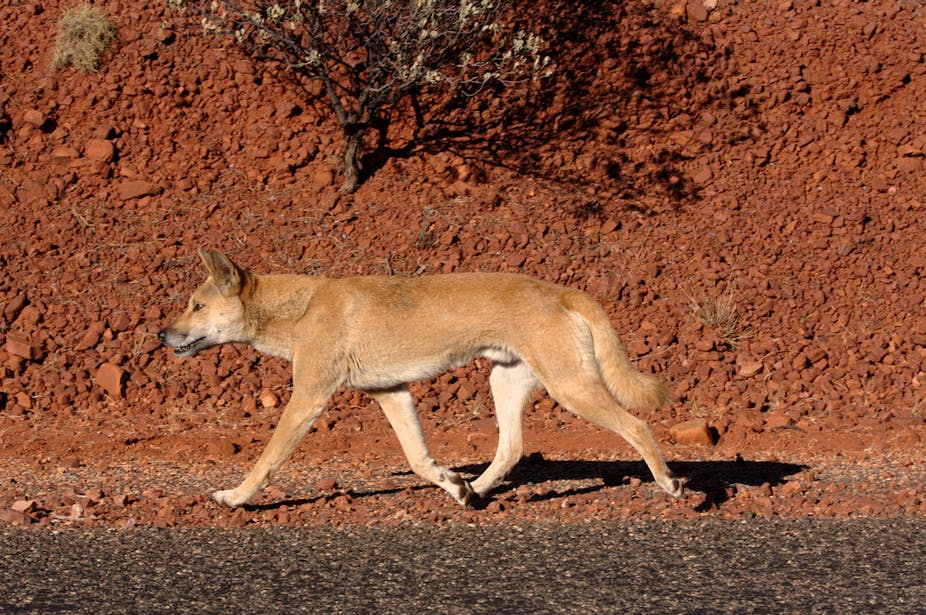The humble dingo has become something of a scapegoat since its arrival in Australia just 4000 years ago. It is widely blamed for the disappearance of thylacines (also known as Tasmanian tigers) and devils from the mainland - an event that left Tasmania as their sole refuge.
The hypothesis is that when dingoes spread through the mainland, they were smarter, faster and more versatile predators than their marsupial counterparts, who lost the battle for survival.
But our analysis might yet earn the dingo a reprieve. We have found evidence that - as with earlier Australian extinction events - humans are the more likely culprits.
Land of the giants
When humans first got to Australia around 50,000 years ago they found a land full of giant animals. There were herbivores like the rhino-sized diprotodon, huge kangaroos, a bird more than twice the size of the emu, and many others. And there were large predators to match. The formidable marsupial lion was the biggest at around 100 kg, but alongside it were other more modestly sized predators, including the thylacine and devil.
The downsizing of Australian wildlife diversity happened in two steps. First, most of the giant animals disappeared in an event known as the Pleistocene megafaunal extinction. They were probably gone by around 40,000 years ago.
The thylacine and devil survived this event, but some time within the last few thousand years, both disappeared from mainland Australia, to hang on only in Tasmania (hence the devil’s modern moniker: the Tasmanian devil).

What caused these extinctions is controversial. Most evidence points to human impact as the main driver of the earlier megafaunal extinction, probably through over-hunting of big and slow-breeding prey. But other factors have also been suggested, such as climate change and landscape burning by people.
In contrast, the more recent mainland extinction of the thylacine and devil is widely viewed as the direct result of the dingo’s arrival on the scene.
Enter the dingo
Dingoes are descended from Asian wolves and were presumably widely transported as semi-domestic animals by seafaring people colonising the Pacific. They made landfall in northern Australia some 4000 years ago and quickly spread to all corners of the continent – but not Tasmania.
The rough coincidence of the dingo’s arrival with the extinction of the two largest marsupial carnivores suggests the natives were undone by a superior competitor. Maybe the dingo was a better hunter; perhaps it was also more aggressive, and killed them off. The fact that thylacines and devils survived on the only large chunk of Australia not reached by the dingo is pretty strong circumstantial evidence for this idea.

But there is another possibility. Evidence has been slowly building that Australia’s human population dramatically changed its behaviour during the past 4,000 years.
Hunting and gathering strategies became more elaborate and probably more efficient, and people became less nomadic. As a result, the population grew, possibly increasing more than threefold between 2000 BC and European arrival.
More people, with better hunting gear, would have had two impacts on thylacines and devils. More would have been killed – we know from other evidence that both species were hunted. At the same time, their prey populations would have been reduced by people. One or both of these factors could have sent them extinct. Crucially, this change in the human population seems not to have happened in Tasmania.
It’s also possible that climate change played a role, through increased variability due to El Niño events. This probably also had bigger impacts on mainland Australia than Tasmania.
New approach
How can we tell which of these factors was the most important in sending the marsupial carnivores extinct? It is hard to think of any type of archaeological or fossil evidence that could distinguish humans or dingoes as the main cause, or test the role of climate variability. The problem is especially thorny because all these factors might have interacted to cause extinction.
Our study, also highlighted in the journal Science), took a new approach. We created a mathematical model of the interactions among predators (people, dingoes, thylacines and devils) and prey (represented by kangaroos) in prehistoric Australia. We also factored in the effects of variable rainfall on vegetation, and knock-on effects on animals. Then we experimented with the model to test which factors had the largest impacts on abundance of thylacine and devils.
The answer was surprisingly clear. The most influential factor in the decline of the marsupial carnivores was human population growth reducing the abundance of their prey.
The other factors - dingoes, climate, and direct hunting of thylacines and devils by people - all increased the likelihood of extinction, but were far less important.
So what have we learned? First, increasing human population size was probably having profound effects on Australian ecosystems for several thousand years before the arrival of Europeans. There is less reason than ever to think that the landscapes seen by the first white settlers represent some kind of stable state of nature in Australia.
Second, we probably need to rethink the role of the dingo in Australian ecology. Rather than wiping out the thylacine and devil, the dingo might simply have replaced them in the ecosystems of mainland Australia, taking over their roles of top predator and scavenger. These roles are significant. As modern societies in Europe and North America are re-discovering, there can be many benefits to having large carnivores in the landscape.
The evidence is growing that without dingoes, Australian ecosystems would be in a lot worse shape than they already are.

